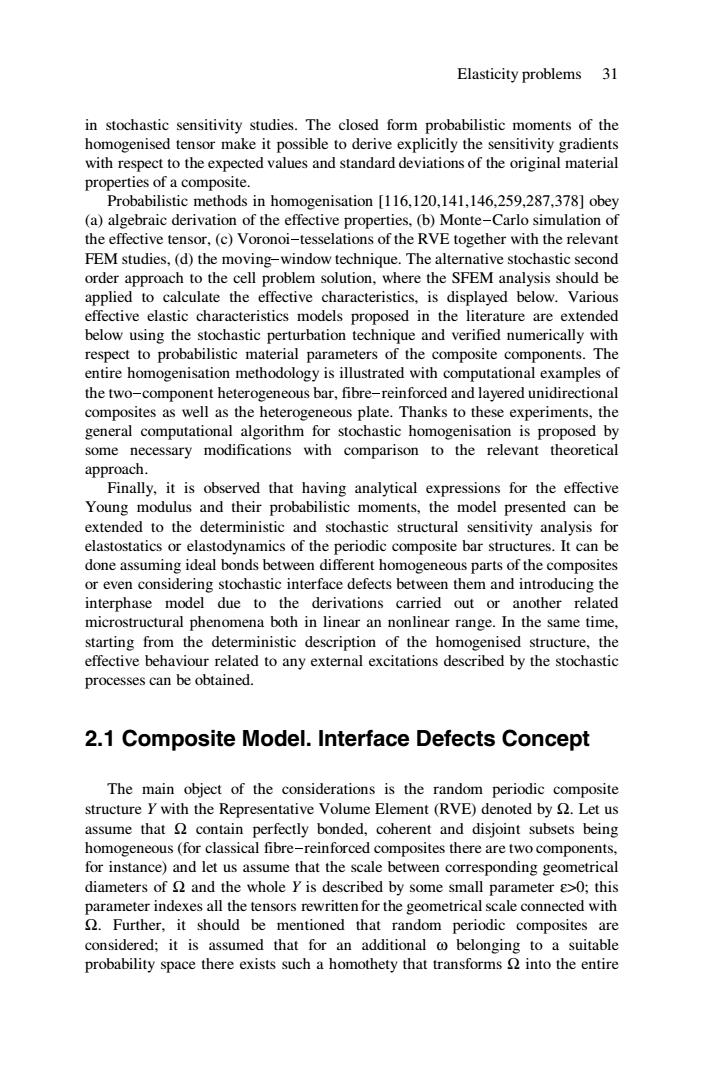正在加载图片...

Elasticity problems 31 in stochastic sensitivity studies.The closed form probabilistic moments of the homogenised tensor make it possible to derive explicitly the sensitivity gradients with respect to the expected values and standard deviations of the original material properties of a composite. Probabilistic methods in homogenisation [116,120,141,146,259,287,378]obey (a)algebraic derivation of the effective properties,(b)Monte-Carlo simulation of the effective tensor,(c)Voronoi-tesselations of the RVE together with the relevant FEM studies,(d)the moving-window technique.The alternative stochastic second order approach to the cell problem solution,where the SFEM analysis should be applied to calculate the effective characteristics,is displayed below.Various effective elastic characteristics models proposed in the literature are extended below using the stochastic perturbation technique and verified numerically with respect to probabilistic material parameters of the composite components.The entire homogenisation methodology is illustrated with computational examples of the two-component heterogeneous bar,fibre-reinforced and layered unidirectional composites as well as the heterogeneous plate.Thanks to these experiments,the general computational algorithm for stochastic homogenisation is proposed by some necessary modifications with comparison to the relevant theoretical approach. Finally,it is observed that having analytical expressions for the effective Young modulus and their probabilistic moments,the model presented can be extended to the deterministic and stochastic structural sensitivity analysis for elastostatics or elastodynamics of the periodic composite bar structures.It can be done assuming ideal bonds between different homogeneous parts of the composites or even considering stochastic interface defects between them and introducing the interphase model due to the derivations carried out or another related microstructural phenomena both in linear an nonlinear range.In the same time, starting from the deterministic description of the homogenised structure,the effective behaviour related to any external excitations described by the stochastic processes can be obtained. 2.1 Composite Model.Interface Defects Concept The main object of the considerations is the random periodic composite structure Y with the Representative Volume Element (RVE)denoted by Let us assume that contain perfectly bonded,coherent and disjoint subsets being homogeneous(for classical fibre-reinforced composites there are two components, for instance)and let us assume that the scale between corresponding geometrical diameters of and the whole Y is described by some small parameter g>0;this parameter indexes all the tensors rewritten for the geometrical scale connected with Further,it should be mentioned that random periodic composites are considered;it is assumed that for an additional c belonging to a suitable probability space there exists such a homothety that transforms into the entireElasticity problems 31 in stochastic sensitivity studies. The closed form probabilistic moments of the homogenised tensor make it possible to derive explicitly the sensitivity gradients with respect to the expected values and standard deviations of the original material properties of a composite. Probabilistic methods in homogenisation [116,120,141,146,259,287,378] obey (a) algebraic derivation of the effective properties, (b) Monte-Carlo simulation of the effective tensor, (c) Voronoi-tesselations of the RVE together with the relevant FEM studies, (d) the moving-window technique. The alternative stochastic second order approach to the cell problem solution, where the SFEM analysis should be applied to calculate the effective characteristics, is displayed below. Various effective elastic characteristics models proposed in the literature are extended below using the stochastic perturbation technique and verified numerically with respect to probabilistic material parameters of the composite components. The entire homogenisation methodology is illustrated with computational examples of the two-component heterogeneous bar, fibre-reinforced and layered unidirectional composites as well as the heterogeneous plate. Thanks to these experiments, the general computational algorithm for stochastic homogenisation is proposed by some necessary modifications with comparison to the relevant theoretical approach. Finally, it is observed that having analytical expressions for the effective Young modulus and their probabilistic moments, the model presented can be extended to the deterministic and stochastic structural sensitivity analysis for elastostatics or elastodynamics of the periodic composite bar structures. It can be done assuming ideal bonds between different homogeneous parts of the composites or even considering stochastic interface defects between them and introducing the interphase model due to the derivations carried out or another related microstructural phenomena both in linear an nonlinear range. In the same time, starting from the deterministic description of the homogenised structure, the effective behaviour related to any external excitations described by the stochastic processes can be obtained. 2.1 Composite Model. Interface Defects Concept The main object of the considerations is the random periodic composite structure Y with the Representative Volume Element (RVE) denoted by Ω. Let us assume that Ω contain perfectly bonded, coherent and disjoint subsets being homogeneous (for classical fibre-reinforced composites there are two components, for instance) and let us assume that the scale between corresponding geometrical diameters of Ω and the whole Y is described by some small parameter ε>0; this parameter indexes all the tensors rewritten for the geometrical scale connected with Ω. Further, it should be mentioned that random periodic composites are considered; it is assumed that for an additional ω belonging to a suitable probability space there exists such a homothety that transforms Ω into the entire